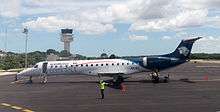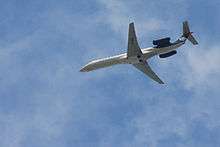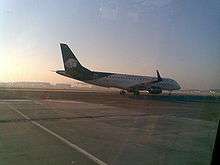Aeroméxico Connect
 | |||||||
| |||||||
| Founded | 1988 (as Aerolitoral) | ||||||
|---|---|---|---|---|---|---|---|
| Commenced operations | 1988 | ||||||
| Hubs |
| ||||||
| Focus cities |
| ||||||
| Frequent-flyer program | Club Premier | ||||||
| Airport lounge | Salón Premier | ||||||
| Alliance | SkyTeam (Affiliate) | ||||||
| Fleet size | 63 | ||||||
| Destinations | 55 | ||||||
| Parent company | Aeroméxico | ||||||
| Headquarters | Monterrey, Nuevo León, Mexico | ||||||
| Key people | Raúl Sáenz (CEO) | ||||||
| Website | aeromexico.com | ||||||

Aerolitoral, S.A. de C.V., DBA Aeroméxico Connect, and formerly as Aerolitoral, is the regional airline of Aeroméxico operating Embraer ERJ-145 and E-190 aircraft, with crew bases in Monterrey, Guadalajara, and Mexico City. It is headquartered in Monterrey.[1] It operates feeder services to AeroMéxico's hub airports, using 4 digit flight numbers. It is considered the biggest and most important regional airline in Mexico, offering more than 300 scheduled flights daily to 42 destinations in Mexico, 10 in the United States and 3 in Central America. Its main bases are Mexico City Airport, Culiacán, Monterrey, and Guadalajara. Other airports with many Aeromexico Connect flights are Hermosillo and Tijuana. The airline offers point-to-point services between other destinations in Mexico and as well to Los Angeles International Airport in the United States.
Aeromexico Connect flights are marketed as Aeromexico.
History
1988 to early 1990s
The airline was established in 1988 as Servicios Aéreos Litoral, to later become a subsidiary of Aeroméxico on December 1, 1990.[2] It started with a fleet of 4 NAMC YS-11 aircraft in 1988 (XA-ROL, XA-ROV, XA-RPU and XA-RRG) and was originally based in Veracruz. In February 1992, AeroMéxico started another regional feeder airline, Aerovías de Poniente, S.A. de C.V. based in Guadalajara using Fairchild Metros. The fleet was replaced and expanded quite fast between 1991 and 1995 and grew to a total of 29 Fairchild Metro III and Fairchild Metro 23 aircraft between the two feeders.
Mid-1990s
In 1991, the main base was moved to Monterrey and in 1992, Aeroponiente started operations from Guadalajara. The pilot seniority list was merged, and a common paint scheme was adopted using the Aeroméxico logo. Since 1992 Aerolitoral has been the only source of pilots for Aeroméxico with more than 400 pilots transferred until today. In 1993, a small base was opened in Culiacán and after 3 months was moved to Chihuahua. By 1995, the commuter airline had 3 bases with 29 airplanes.
The route network expanded all across the north of Mexico, and some routes to the United States were operated for a brief period, such as: Harlingen, McAllen, Corpus Christi, and Austin in Texas as well as to Albuquerque, New Mexico. The main US routes operated in this period were San Antonio; Tucson; El Paso; and Phoenix.
In 1996, the two airlines were merged into AeroLitoral S.A de C.V., causing some labor problems to continue during 1997, and a pilot strike in the same year. There was a high demand for a bigger airplane in the route network and the Fairchild Metro 19 seater was not enough. After a long selection, Saab 340B's were introduced in late 1997. In 1998 new services to the United States were added from Piedras Negras. and from Chihuahua to Dallas.
In early 1999, AeroLitoral was operating 29 Fairchild Metros and 6 Saab 340Bs. One Fairchild Metro XA-RYY had been converted to freighter and operations to Mexico City were resumed on behalf of Aeromexpress. In August 1999 a new CEO was appointed and Raúl Sáenz Campos replaced Carlos Treviño Treviño after a long time being at the airline. On December of the same year, the directive board decided to start a fleet renewal process, by replacing the first 3 Fairchild Metros .
Early 2000s
In the period between the years 2000 and 2002, 13 more Saab 340Bs were added to replace Metros, with a peak fleet of 22 Saab 340B's. On the third quarter of 2001, services to San Diego via Mexicali, to Zacatecas via Puerto Vallarta, and Monterrey were launched. Nevertheless, these services were discontinued shortly after 9/11 Attacks. On September 6, 2001, there was an accident without any fatalities, it was a Saab 340B's with registration XA-ACK which crash-landed 15 miles southeast of Tijuana. The airplane suffered fuel starvation, due to a false indication in the flight deck fuel gauges, caused by a defective element on the system, reflecting more fuel than the aircraft actually had.
After the September 11, 2001 attacks, AeroLitoral experienced a drop in air traffic and downsized the fleet in order to survive. Services to San Diego, El Paso, and Laredo were cancelled. San Antonio, Phoenix, and Tucson were reduced, moreover with the growth of Aviacsa on the domestic market with its Boeing 737-200 fleet invading the most profitable routes from Monterrey to León, Ciudad Juárez, Culiacán, and Guadalajara. The small commuter experienced severe financial troubles, and in 2002, many employees were laid off, among them 50 pilots. In 2002, services to Los Angeles and Ontario, California were introduced on behalf of Aeroméxico, while services to Phoenix and Laredo were cancelled.
In early 2003, with a fleet of 3 Fairchild Metro and 22 Saab 340Bs, the load factors were recovering as with many other airlines around the globe. That same year, AeroLitoral announced the acquisition of the first 5 Embraer ERJ 145, with deliveries starting in mid-2004. In December 2003, after operating a peak fleet for 13 years with 28 planes, the last 3 Fairchild Metro were retired. Early the next year, the first 3 ERJ-145's arrived from Brazil to Monterrey and started to replace the Saabs on the routes from Monterrey lasting over 1 hour 50 minutes. The first flights were mainly to Chihuahua, Guadalajara, and Ciudad Juárez, and two of the same aircraft were added later that year. In this same year, a wet lease contract from was signed between Aerocaribe and AeroLitoral. The agreement stated that AeroLitoral would provide service in the routes on the South East of the country on behalf of Aerocaribe. The contract covered the wet lease of 3 Saab 340Bs operating the routes to Mérida, Tuxla Gutierrez, and the shuttle between Cancún and Cozumel. The agreement lasted a year and ended in late May 2005.
Mid 2000s

In 2005, the first scheduled services in and out of Mexico City on behalf of Aeroméxico were introduced to Ciudad Obregón and Los Mochis, using ERJ-145 aircraft. During this year, 5 more ERJ-145s were introduced to the fleet, introducing new routes to Central Mexico and the Southeast of the country, as well as increasing the size of the fleet to 10 aircraft.
In 2006, AeroLitoral took over services from Mexico City to Campeche and Durango, previously operated by Aeromar on behalf of Aeroméxico, and resumed operations to Reynosa, Oaxaca, and other Aeroméxico non-revenue city pairs. By the end of 2006, an ERJ crew base in Mexico City was established, 13 more ERJs were introduced to the fleet, most of them in addition, bringing the number of 23 by the end of the year.
2007: this year, AeroLitoral returned to Austin on behalf of Aeroméxico from Mexico City, reopened the hub in Guadalajara with ERJ's, fleet which grew to 32 frames. In November 2007, Aeroméxico announced that AeroLitoral was going to become Aeroméxico Connect once the E-190's arrived, and so did. The airline changed its corporate name, image, and introduced a new philosophy of complementing Aeroméxico on some domestic and international flights, instead of only feeding the airline's hubs. The first 4 brand new Embraer ERJ 190 arrived in October 2007 and early 2008, and the airline already announced an order for 12 more frames that will start arriving in early 2009. On November, SkyTeam painted Aeroméxico Connect's E-145 in SkyTeam livery.
Destinations
Aeroméxico Connect has grown through the past few years on the Mexican domestic market. It has come from being a feeder airline to a key on Aeroméxico's strategy to remain in the industry. As new aircraft have been added since 2004, Aeroméxico has been shifting many of its domestic and short-haul international routes to Aeroméxico Connect. The intended plan of the holding consortium of the two airlines is to keep developing Aeroméxico Connect on those markets where mainline Aeroméxico would not profit, moreover after the addition of the Embraer E-190 that is capable of operating on some longer routes that were formerly served by mainline Aeroméxico with DC-9 or McDonnell Douglas MD-87 aircraft. Also of interest is the airline´s choice to replace some Embraer 145 fleet with newer Embraer 190 and Embraer 170 jets, currently under manufacture for Aeroméxico. Three new Embraer 170s arrived in the summer of 2012. The will announced the replacement to ERJ 145 later. The airline serves international destinations in El Salvador, Guatemala, Honduras, Nicaragua and The United States, while offering serving regional routes throughout Mexico.
Fleet
Aeroméxico Connect has an all-Embraer fleet that consists of the following aircraft (as of September 2016):[3]
| Aircraft | In Service | Orders | Options | Passengers | Notes | ||
|---|---|---|---|---|---|---|---|
| C | Y | Total | |||||
| Embraer ERJ-145 | 0 | 50 | 50 | XA-CLI painted in SkyTeam livery. | |||
| Embraer ERJ-170 | 0 | 76 | 76 | XA-ACV painted in SkyTeam livery. | |||
| Embraer ERJ-175 | 0 | 86 | 86 | Options are to be fitted with new Wingtip | |||
| Embraer ERJ-190 | 11 | 88 | 99 | ||||
| Total | 65 | 3 | 5 | ||||


As of November 2014, the average age of Aeroméxico Connect's fleet is 10.6 years.[4]
Accidents and incidents
- On 6 September 2001 at 12:35 local time, an Aerolitoral Saab 340 (registered XA-ACK) encountered a failure of its second engine, forcing the pilots to perform an emergency landing on a field in Valle de Las Palmas. The aircraft had been operating Flight 2130 from Ciudad Juárez to Tijuana with 29 passengers and three crew members on board, none of which were seriously injured, even though the airplane was damaged beyond repair.[5]
- On 21 January 2010 at 12:24 local time, Aeroméxico Connect Flight 2051 from Hermosillo to Los Angeles veered off the runway upon diverting at General Abelardo L. Rodríguez International Airport in bad weather conditions which included gusty winds. There were no injuries among the 39 people on board the Embraer ERJ 145 involved (registered XA-WAC), which was repaired and returned to service.[6]
- On 10 May 2010 an Embraer ERJ 145, registered operating as Aeroméxico Connect Flight 921 reported an unsafe gear indication upon approach. On board the flight, with service to Mexico City from Monterrey, were 27 passengers. The crew aborted the approach and entered a holding for troubleshooting, the unsafe indication continued. After a subsequent low approach the tower reported all gear appeared to be properly down. The airplane landed safely about 30 minutes after aborting the first approach.[7]
- On 23 June 2011, Aeroméxico Connect Flight 2471 with service to Mexico City from Nuevo Laredo, was hit by two rays of lightning. The Embraer ERJ 145, registered XA-SLI with 43 people on board, suffered system damage. Smells of smoke in the cockpit caused the pilots to divert to Monterrey for a safe landing. No injuries were reported, and the plane sustained minor damage.[8]
- On 17 March 2012 an Embraer ERJ 145, registered XA-TAC encountered a loss of cabin pressure. Flight 2469 was en route to Monterrey from Veracruz with 48 passengers and 3 crew. At FL320 near Tampico, Tamaulipas, the crew initiated an emergency descent and a diversion to General Francisco Javier Mina International Airport. The aircraft landed safely with no injuries reported.[9]
References
- ↑ "Directory: World Airlines." Flight International. March 16–22, 2004. 50. "Carretera Miguel Aleman Km 22.8, Monterrey, Nuevo Leon, 66600, Mexico."
- ↑ "Directory: World Airlines". Flight International. 2007-03-27. p. 49.
- ↑ http://www.airfleets.net/flottecie/Aeromexico%20Connect.htm
- ↑ "Aeroméxico Connect Fleet Details and History". Retrieved 4 June 2015.
- ↑ Harro Ranter (6 September 2001). "ASN Aircraft accident Saab 340B XA-ACK Tijuana". Retrieved 4 June 2015.
- ↑ Harro Ranter (21 January 2010). "ASN Aircraft accident Embraer EMB-145LU (ERJ-145LU) XA-WAC Tijuana-Rodriguez Airport (TIJ)". Retrieved 4 June 2015.
- ↑ "The Aviation Herald". Retrieved 4 June 2015.
- ↑ "The Aviation Herald". Retrieved 4 June 2015.
- ↑ "The Aviation Herald". Retrieved 4 June 2015.
External links
- Aeroméxico
- Aeroméxico Connect (Archive)
- Aerolitoral (Archive)
- Aerolitoral (Archive) (Spanish)